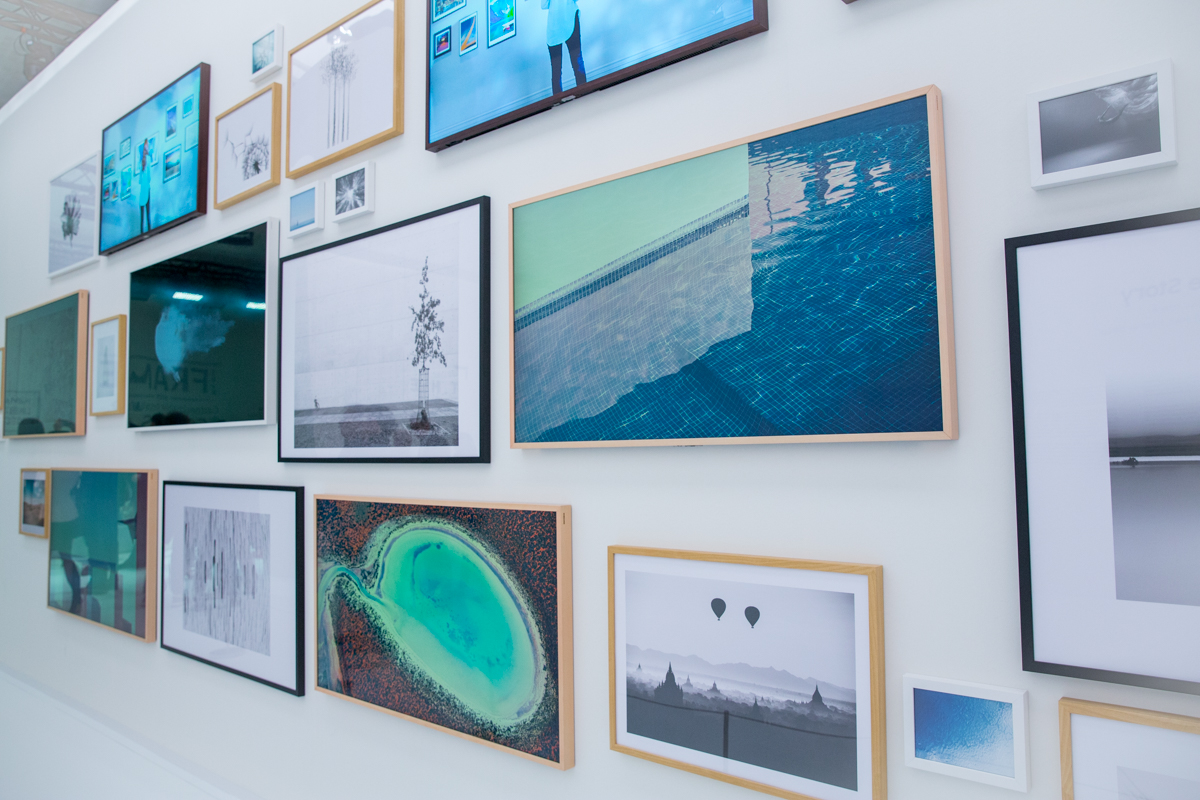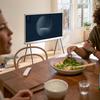
Lately we have been constantly hearing talk about the high rate of change in the modern world, about a certain
Samsung Designer Televisions: The Frame and The Serif's First Public Appearance
For the first time we learned about this direction of developmentTVs in 2017 at the presentation of Samsung's QLED TV line in Paris. Then only concepts were shown that reflected only the visual component of this idea: it was about rethinking the modern role of the TV and expanding its use cases, making it even more useful in the home. Designers openly experimented, trying to find interesting solutions that can interest buyers and find a response in their hearts. For example, they used the idea of the so-called 360-degree design, which appeared on Samsung TVs in 2016. That is, the TV should look beautiful from any angle, including if it stands in the center of the room and you look at it from behind. It is interesting to observe the development of the idea of the stand - since we are talking about paintings, why not offer an option with a stand like an easel? The concepts had more options for a round stand, but in the end they all refused it (that's why they were concepts).
Samsung The Frame concept: the essence of the idea
And this is what Samsung TVs looked like in real lifeFrame series and they have practically not changed in appearance. The key visual image was the idea of a painting placed on the wall and capable of broadcasting a static image in the time free from the main work of the TV. LG uses something similar in its series of designer air conditioners, but Samsung has gone even further, because the TV opens up unlimited possibilities for displaying pictures, as opposed to static posters printed on paper. Part of Samsung's The Frame concept was the use of interchangeable frames to better fit the TV into the interior. And, if necessary, replace the frame.

</ img>

</ img>

</ img>

</ img>




Samsung The Serif concept: the essence of the idea
If The Frame series televisions are more appropriate onto the wall of the room, the The Serif series was created in order to place the TV on high legs and beat it in the interior. For this, for example, its frame is made wide to play, if necessary, the role of the shelf. But in general, just two years ago, in addition to the visual idea, this concept had nothing (and it was not even planned to be sold in Ukraine), but now the Serif idea has been filled with meaning, correctly packaged and focused on the chosen target audience, without forgetting about the technical capabilities.

</ img>

</ img>


Why all this complexity? It's just a TV
Difficulties begin when they changeconsumer habits. Ask 18-year-olds what they think about TV? In most cases, they will tell you that they don’t watch TV, meaning that they don’t watch traditional linear (terrestrial) TV channels - the same scenario that their parents and grandparents have. But does all this mean that 18-year-olds will not use TV at all? Of course not! TV is and will always be the best device for watching video in all its forms. It has a huge screen and powerful acoustics - all this will never be found in smartphones, tablets, or computers. The only question is how to properly present the idea of TV in a new way. And this should be done not only for 18-year-olds, because they have not yet entered the stage of respectable buyers (they are still studying, and, as a rule, they do not earn money on their own).
Well, then who needs these designer TVs?
A TV that can turn into a picture onThe wall can appeal to everyone who, at a minimum, appreciates and loves art. These are designers, people of any creative professions (artists, musicians, journalists, and so on). Although in fact, if you ask your wife, she also will not give up the TV on the wall, which can turn from a black spot on the wall or informational noise in the form of a film, television channel or series into a seascape, still life or a world painting masterpiece, which is larger Everything suits the current situation and helps to create the right atmosphere: birthday, romantic evening, meeting with parents or parties.
What makes Samsung The Frame TVs different?
Samsung The Frame series TVs are the bestlook on the wall, where they are not just part of the interior, but actively influence its perception. Instead of turning off the screen, they do not spoil the view of the room with a black rectangular blob, but in the “Picture” mode they display one of 1,200 paintings by famous artists and photographers, selected from the largest galleries and museums in the world: the Louvre, the Prado, the Victoria and Albert Museum. There are paintings from the Albertina, Tate and Uffizi galleries. All of them are available on the TV app called "Art Store".

</ img>

</ img>

</ img>

</ img>

</ img>





And also on TVs of The Frame seriessix color options for frames that can be changed from black, white, walnut and beige, light beige and burgundy. This is what the series’ promotional video used in Ukraine looks like:
What is the difference between Samsung The Serif TVs
If Samsung The Frame is TVs,turning the interior into paintings, then Samsung The Serif is in itself the embodiment of modern design. Their appearance was developed with the participation of brothers Ronan and Erwan Bouroullec. Today they are among the world's most renowned furniture designers. Samsung The Serif TVs have a metal base, a stylish wide frame that can act as a stand or shelf in the interior, and the same 360-degree design that allows such a TV to fit even into the center of the room. Unlike Samsung The Frame, created for classic interiors and buyers under the age of 35, The Serif series is more technological, interactive and aimed at active youth (target audience under 25 years old) who are ready to experiment. In addition to the ability to display paintings, these TVs have a special Serif Ambient mode, in which, in addition to classical paintings, works of contemporary artists and designers can be displayed, as well as interactive features - clocks, family photo galleries, abstract compositions. These TVs also support NFC and easily interact with smartphones, allowing you to stream content from them after simply touching the TV.

</ img>

</ img>

</ img>

</ img>

</ img>

</ img>






Here's Samsung's promotional video for the series:
And here is a short video with an emphasis on Ambient mode:
Special project
A laptop from the future: review of the ASUS ZenBook Duo Pro with two touch screens
What's under the hood of Samsung The Frame and Samsung The Serif TVs?
Most often, gadgets with an emphasis on appearancedo not have the most advanced technical characteristics. But in this case, both of these designer TV series are equipped to the highest standard. What you should pay attention to:
- Screen technology -QLED(we wrote about the benefits of screen technology onquantum dots, for example, here and here). The very fact that Samsung recommends using static images in standby mode suggests that the company is not worried about the panel burn-in effect that all competitors with OLED panels in TVs are susceptible to.
- CPUQuantum 4Kwith support for 4K resolution and artificial intelligence technologies that improve sound and video in real time
- Standard supportHDR10 +. Extended dynamic range comes to TVs and is becoming the de facto standard for new films and TV shows
- Technologiessmart homeusing the applicationSmartthingsand voice control
- Supports Apple AirPlay 2 technology, allowing you to easily stream music from Apple devices
In addition, as I said, for TVsThe Frame series will have interchangeable frames available, while Serif TVs have NFC support for simplified data transfer from a smartphone. And interactive Ambient themes in standby mode.
Prices and Diagonals
I don’t know why, but any price announcements causegeeks have a violent negative reaction, as if everything new should cost, if not cheaper than the old, then at least the same. In practice, this only happens with equipment that uses technologies from previous years. This is always clearly visible on smartphones in the middle and lower price segments - every year they offer something that is already available in older models, but a little cheaper than before. Each time, thus stimulating new demand. This doesn't work with design. Unusual and new design itself has the power to attract buyers' attention and create value that buyers are willing to pay for. Therefore, one cannot expect prices for designer TV models to be at the level of the “bottom” of the market. Although there is nothing cosmic (compared to other QLED TVs) about them either.
On the Ukrainian market, Samsung TVs from The Frame series will be sold with diagonals of 43″, 49″, 55″ and 65″. With prices starting from 32,999 hryvnia.
Samsung TVs of The Serif series will be presented with diagonals of 43″, 49″ and 55″. Their price starts from 29,999 hryvnia.
In the dry residue
What do we see in this new direction?TVs? Samsung is turning a new page in the history of these devices by being ahead of the curve and offering consumers new sensations and new user experiences. TV screens are evolving and becoming larger, taking up more and more space in our homes. Therefore, for people with a heightened aesthetic perception, it makes sense to think about how a huge TV hanging on the wall can turn from an ugly black spot into a part of the interior that actively participates in creating the necessary atmosphere. And change depending on the time of year, day and even the mood of its owner. And if the Samsung The Frame series is created for more conservative buyers with good taste and a love of fine art, then the Samsung The Serif series will appeal more to the young and courageous, accustomed to living in a constantly changing world, where today it is worth trying one thing, and tomorrow another. Where nothing is static, and the world is filled with constantly changing information coming from all corners of the information-saturated world. No one yet knows how such an experiment will end. Perhaps this will completely change our perception of televisions and in 5-7 years they will all have such capabilities. Or maybe an offshoot of designer TVs will appear and they will become a separate subclass. Everything is in the hands of buyers. They are the ones who determine the development of technology in the modern world.